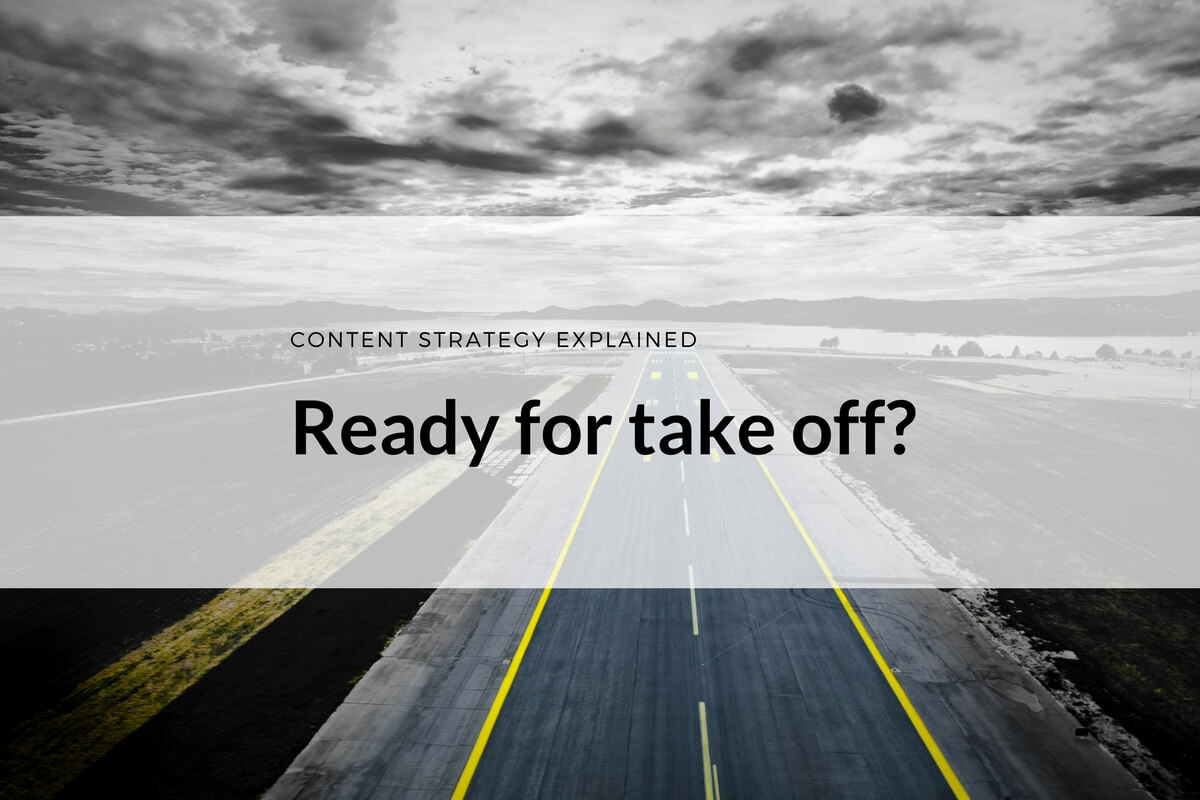Content Strategy has a lot in common with air travel when you think about its various components.
In my latest blogpost on the idea of a “minimum viable content strategy“, I use the analogy of a plane to explain content governance.
I regularly use this analogy when onboarding new clients onto our content marketing platform, and was again reminded of this upon reading an excellent post by the Content Marketing Institute on implementing a content platform.

Since it’s been so helpful to many of my clients, I’m going to share with you this analogy to help you gain a better understanding of what is content strategy and how to implement it seamlessly into your day-to-day activities.
![]() This piece, of which I am the author, has been originally published on the Scribblelive blog.
This piece, of which I am the author, has been originally published on the Scribblelive blog.
Content Strategy is Like a Plane
A plane is a very complex object that’s revolutionized the way we perceive our world. Getting from A to B has never been easier, and the world has become a smaller place.
But even though flying seems to be quite trivial nowadays, it’s one of the most technological advances of our time – a complex field of expertise that involves a whole lot of puzzle pieces fitting together. And if I may be so bold…a lot like content strategy.
How do we get it in the air with passengers on board?
When you (i.e. the customer) get on a plane, from the time you arrive to the airport until you are in the air, there are clear rules and processes to follow. You arrive at the airport, check in, get through security, board the plane, find your seat, and then (hopefully) follow the instructions of the pilots and flight attendants.
The pilot (i.e. the content strategist) speaks with the control tower (i.e. C-level management) and takes care of all technicalities and roadmap approvals. Depending on duration of the flight and size of the plane, the pilot is assisted by a co-pilot.
Flight attendants (i.e. the content team) make the flight as pleasant as possible for passengers (i.e. your stakeholders / clients / potential customers…), handing out complimentary food and beverages (i.e. useful content!) informing them of any turbulences and communicating regularly with the cockpit.
Who sits in the cockpit?
 The pilot (and co-pilot) sit in the cockpit. They’re the experts in knowing how to fly that plane while making sure to communicate with all people on the plane (i.e. the content team and stakeholders) and control towers (i.e. C-level management). To do so, they’re equipped with a variety of control instruments and dashboards that tell them if they are on track, where to make adjustments when necessary and what to keep sight of.
The pilot (and co-pilot) sit in the cockpit. They’re the experts in knowing how to fly that plane while making sure to communicate with all people on the plane (i.e. the content team and stakeholders) and control towers (i.e. C-level management). To do so, they’re equipped with a variety of control instruments and dashboards that tell them if they are on track, where to make adjustments when necessary and what to keep sight of.
Obviously, this is not an easy task and requires a lot of concentration and effort to get from A to B. Parts of the flight can be taken over by an autopilot (i.e. artificial intelligence, marketing automation, content automation, etc.) but that sure doesn’t mean the pilot doesn’t have to stay in the cockpit and pay attention…
What happens during the flight?
During the flight, it may seem like nothing exciting is really happening, but there are clear rules and guidelines around how to get from A to B, and what to do, especially during unexpected and potentially hazardous situations. For example, if there are turbulences, the flight attendants know how to calm down passengers. In some cases, the pilot will make announcements directly to passengers to communicate the situation. (I advocate for this to happen more: content marketing strategists need to keep in touch with stakeholders, the market and most importantly, customers!)
For longer flights, switch personnel when they need to rest (i.e. get freelance help if the content team is overloaded), provide food and entertainment for your passengers (i.e. engaging content)…overall, make it an enjoyable experience for everyone involved.
The key takeaway is to stick to the roadmap, take care of your passengers, be prepared to make adjustments, and communicate, communicate, communicate!
How do we keep the plane in the air?
If you’ve ever seen the show “Mayday“ (I know, not ideal for people who might have a fear of flying!), you may know that it takes quite a bit of maintenance to keep a plane safely in the air. Just a small human error or technical failure can unleash a catastrophic chain of events (albeit, no one dies if a content strategy fails, I’ll give you that).
Although passengers may not see or be aware of what’s going on behind the curtain, it should be a priority and substantial part of an airline to keep the plane in good condition by making updates to systems, repairing or replacing parts (i.e. content updates and maintenance), and having a planned and consistent schedule.
And of course there’s the technological side to it. You can’t transport your passengers on something you’ve put together with duct tape. You need the best fitting tech solution to be able to fly safely from A to B (i.e. to plan, create, and execute your content strategy).
Let me be honest: technology can be expensive depending on how sophisticated you want your plane (i.e. content strategy), and everyone involved will need training, but then again, a pilot can’t fly without getting training and certification. And it wouldn’t be in the best interest of anyone if airlines made flights so cheap that security and quality could not be guaranteed.
Depending on the maturity stage of your strategy and content operations, it’s quite possible that flying with a duct taped plane (i.e. free tools used for different tasks, spreadsheets, etc.) works for you, but it certainly shouldn’t be your endgame. If you don’t have many passengers and/or resources, you’ll probably be fine with just a small aircraft that’s not too complicated, but be smart and stay ahead of the game. Always think of the next step(s)!
If you want your passengers to come back for future trips and stay loyal, you’re going to have to step up. At some point, you might want to invest in a more sophisticated plane that gives you better insight into everything that’s going on in your plane (even though it can be a little more difficult to fly).
Conclusion: no, it may not be “easy”, but it will revolutionize your passenger’s world
It took decades for air travel to become what it is today. It may seem trivial for customers now, but this mode of transportation (i.e. the customer journey and experience) has been a game changer.
[Tweet „If you think of it: content strategy is a lot like air travel and flying a plane.“]
The way we think of how to be useful to audiences (because we can’t afford not to be, anymore!) while reaching organizational goals is constantly transforming. So, keep up with the evolving technology and you will reap the benefits down the line.



